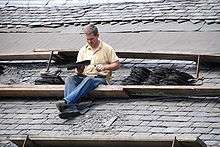Slater

A slater, or slate mason,[1] is a tradesman who covers buildings with slate.[2]
Tools of the trade
The various tools of the slater's trade are all drop-forged.[3] The main trimming and holing bar is called a Bench Break or Bench Dresser, the portable steel is called a Roof Break (Bryan N Rowbotham FIoR)

The slater's hammer is forged in one single piece, from crucible-cast steel, and has a 12-inch (30 cm) leather handle. It consists of a claw for drawing nails, a sheer edge for cutting slate, and a head with a sharp point at one end for punching holes in slate and with a hammer head at the other.[3][4]
The ripper or Rip is also forged from crucible-cast steel and is 24 inches (60 cm) long. It consists of a blade and a hook, and is used for removing broken slate.[3] The hook can be used to cut and remove slating nails.[5]
The slater's stake is T-shaped. The vertical bar of the "T" is pointed to allow it to be driven into a rafter or other woodworking surface. The horizontal bar of the "T" is used to support slates whilst working on them (cutting, punching, or smoothing) with other tools. The long bar of the stake can also be used as a straight edge for marking.[3][4]
The zax (also called a sack or sax[6]) is a hand tool for cutting, trimming, and punching nail holes in slate. It consists of a heavy rectangular knife blade with a large point, of square cross section, protruding from the poll (or butt). The blade edge is used to split slate, while the point is used to pierce square holes for mounting the slate on the roof (with square copper nails) or making a series of small holes marking a line where the slate is broken over a slater's iron. The tool is mounted to a laterally offset handle to protect the user's hand from sharp slate chips.
References
- ↑ Sir Banister Fletcher, Herbert Phillips Fletcher (1888). Quantities; a Text-book for Surveyors, in Tabulated Form. B. T. Batsford. p. 23. ISBN 1561582115.
- ↑ C. Tomlinson, ed. (1852). "SLATE". Cyclopædia of Useful Arts & Manufactures. p. 636.
- 1 2 3 4 Robert Scharff and Terry Kennedy (2000). Roofing Handbook. McGraw-Hill Professional. p. 289. ISBN 0071360581.
- 1 2 Taunton Press Staff (1997). Roofing. Taunton Press. p. 48. ISBN 1561582115.
- ↑ Kennedy, Terry (2002). Roofing Instant Answers. New York: McGraw-Hill. p. 332. ISBN 0-07-138712-9.
- ↑ George Ripley and Charles Anderson Dana (1862). "SLATE". The New American Cyclopaedia: a popular dictionary of general knowledge. New York: D. Appleton and Company. p. 695.
Further reading
- Peter Mytton-Davies (1988). Practical Guide to the Repair and Maintenance of Houses. Spon Press (UK). pp. 117–118. ISBN 1850320160. — further information about slater's tools